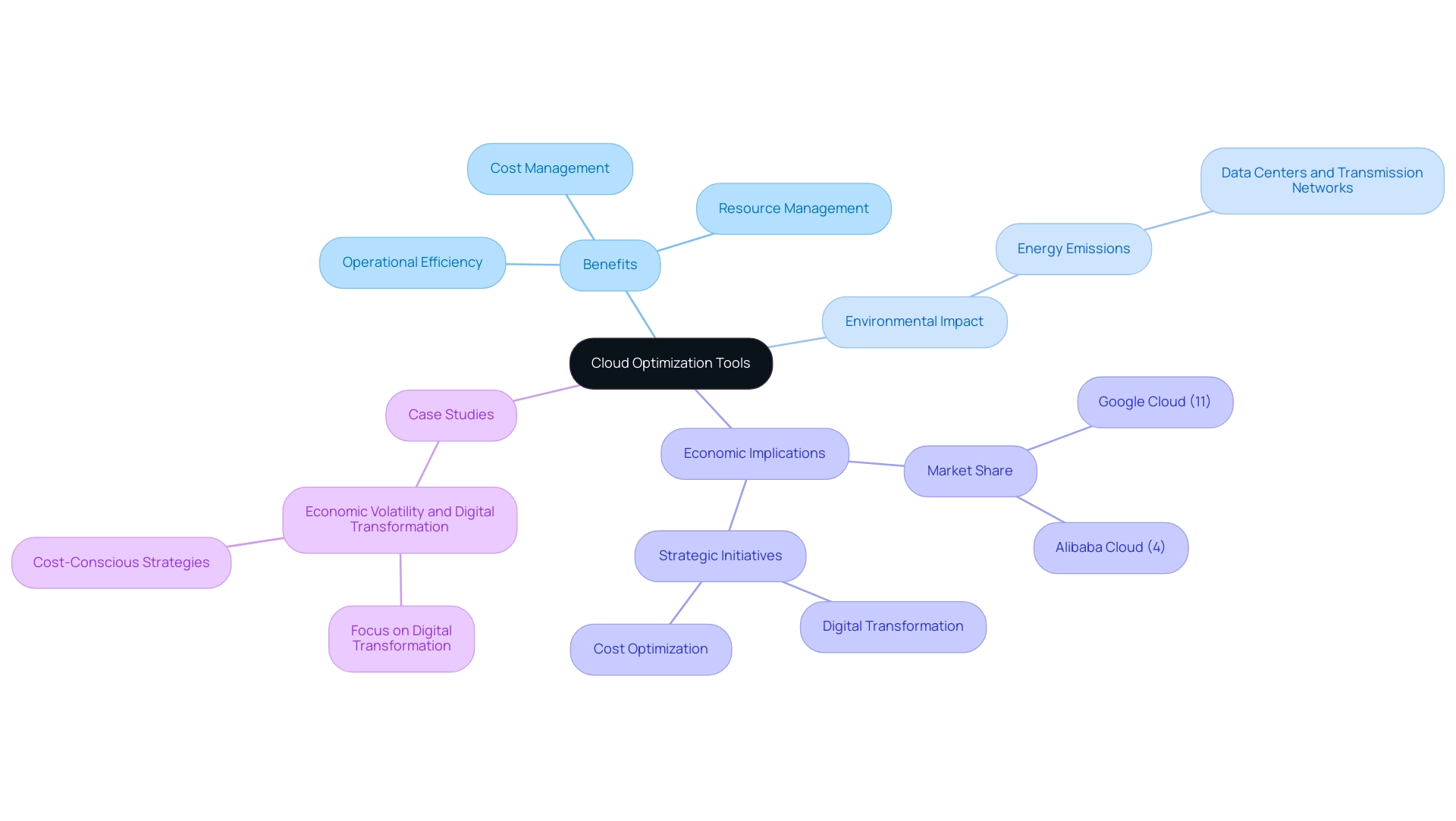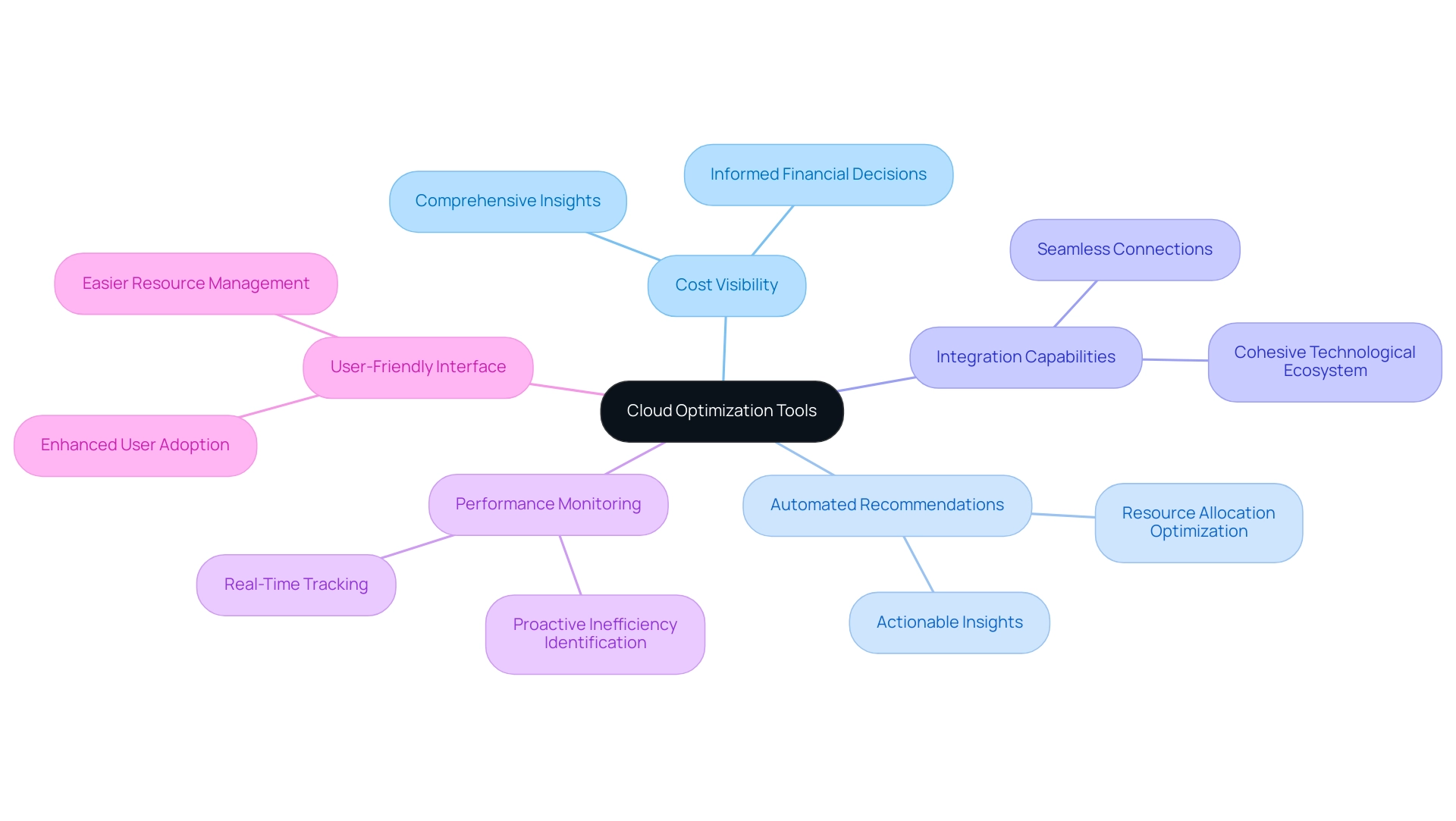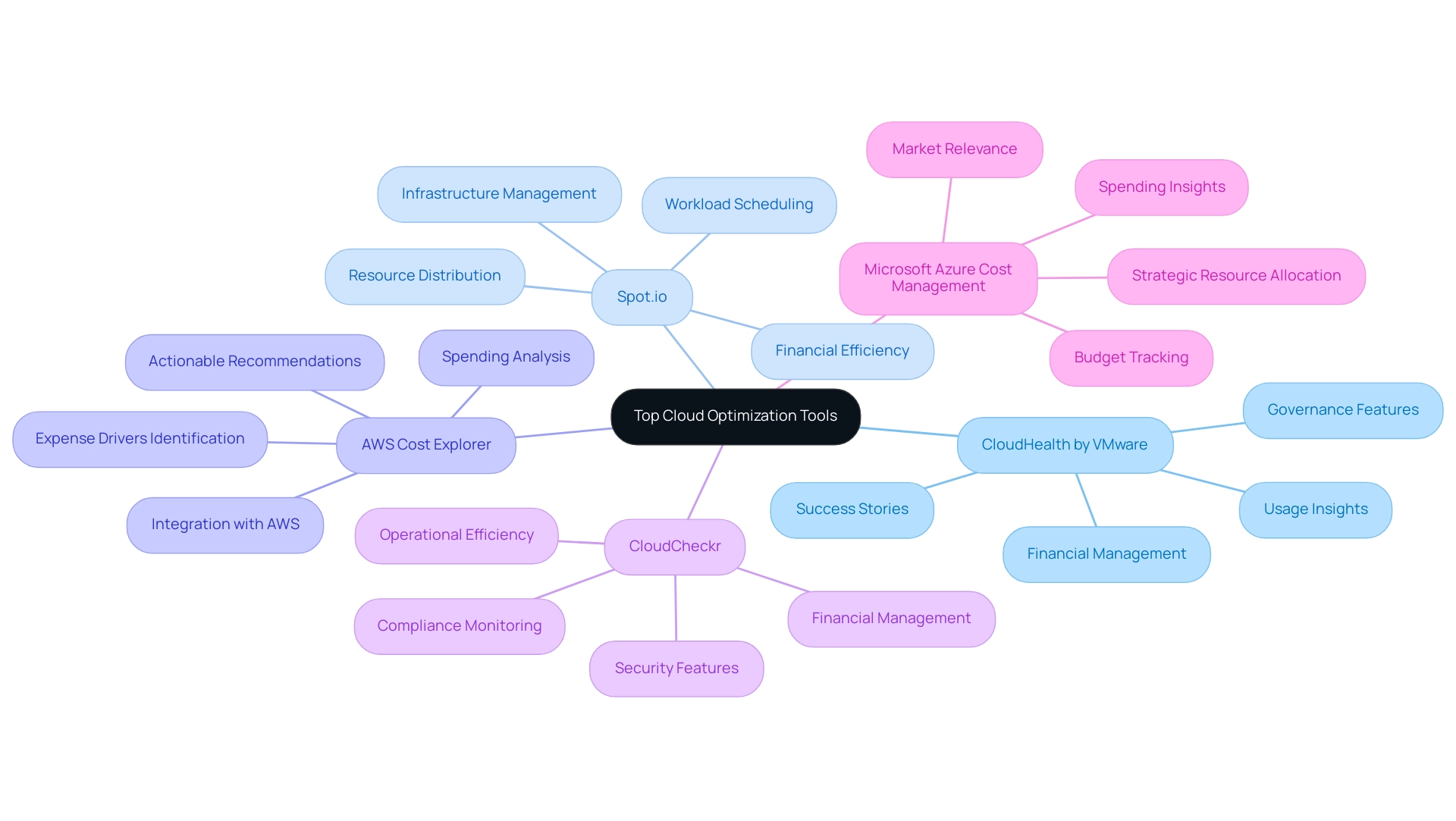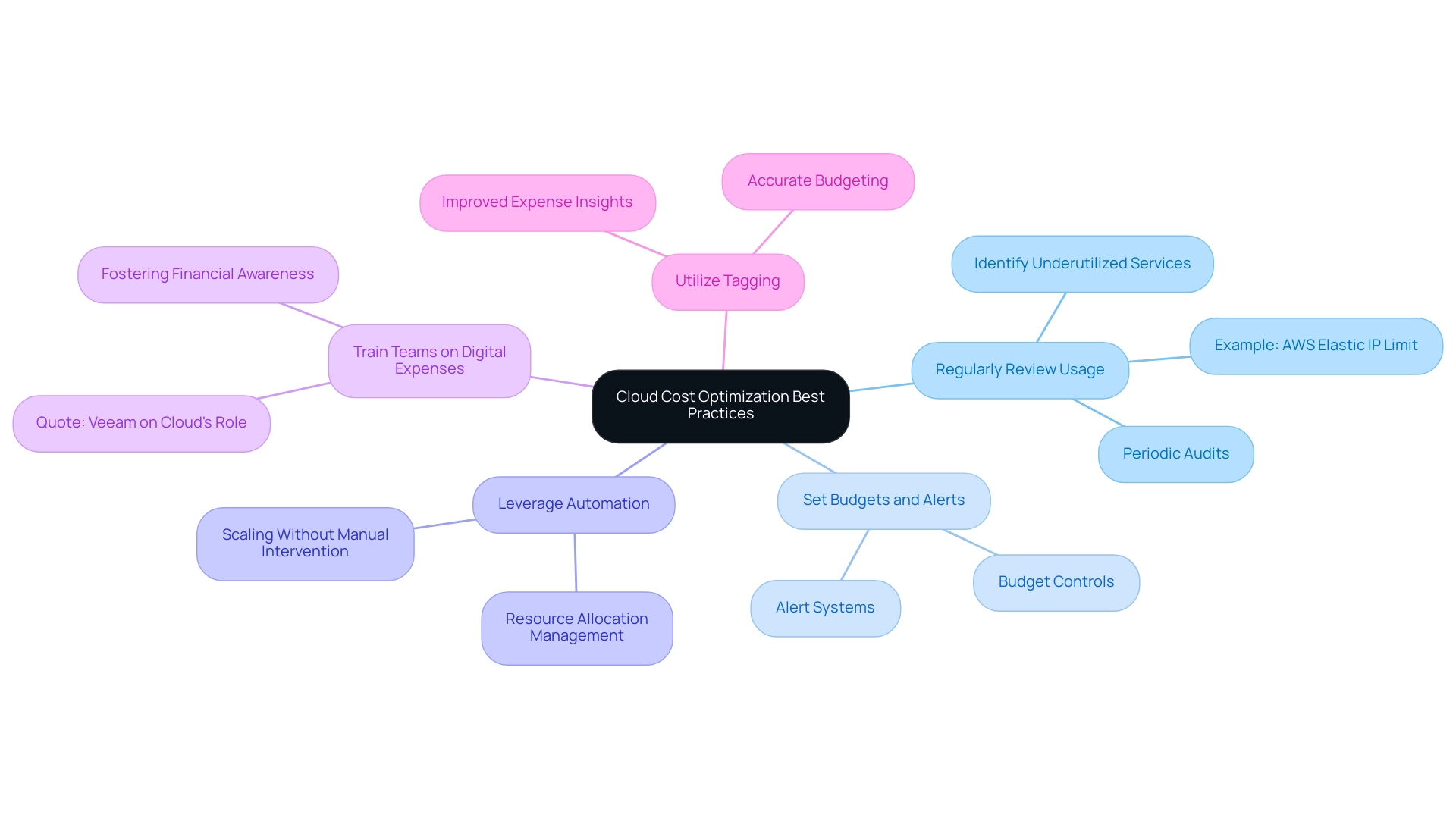Introduction
As organizations increasingly embrace cloud computing, the significance of cloud optimization tools has never been more pronounced. These essential solutions not only provide visibility into resource usage but also automate allocation and analyze spending patterns, thereby preventing costly overspending. In a landscape where nearly half of businesses view cloud computing as a modern strategy for data protection, effective resource management is critical.
This article delves into the key features that organizations should consider when evaluating cloud optimization tools, presents a comparative analysis of the top options available, and outlines best practices for effective cost optimization. Furthermore, it explores future trends that are set to redefine the cloud optimization landscape, ensuring that enterprises remain competitive and financially sustainable in an ever-evolving digital environment.
Understanding Cloud Optimization Tools: An Overview
Resource optimization applications are considered the best tools for cloud optimization as they serve as crucial software solutions that enable organizations to oversee and improve their digital assets. As companies progressively shift to online platforms, the need for the best tools for cloud optimization to gain insight into usage, automate resource distribution, and examine expenditure trends is expanding rapidly. Such capabilities are not merely beneficial but critical in preventing overspending.
By identifying underutilized resources and suggesting necessary adjustments, the best tools for cloud optimization enhance operational efficiency and align with digital transformation initiatives. Significantly, online computing is regarded as a contemporary approach for data security by almost half of the businesses surveyed, highlighting the significance of resource management solutions in the current environment. Moreover, data centers and transmission networks account for 1% of energy-related CO2 emissions, highlighting the environmental significance of effective resource management.
As Cody Slingerland observes, 'Together, these two regions represent 82% of the global computing resources,' highlighting the scale at which optimization tools function. As enterprises navigate economic disruptions, utilizing the best tools for cloud optimization of digital resources becomes imperative to maintain competitiveness and ensure financial sustainability. The case study titled 'Economic Volatility and Digital Transformation' illustrates how entities can effectively navigate these challenges through strategic initiatives, reinforcing the importance of optimization in a competitive landscape.

Key Features to Consider in Cloud Optimization Tools
When assessing optimization solutions, companies must prioritize several essential characteristics that enhance efficiency and cost-effectiveness, particularly the best tools for cloud optimization in their digital environments.
- Cost Visibility: A robust tool should provide comprehensive insights into spending across various departments and projects, enabling organizations to make informed financial decisions.
As noted by Veeam, > The virtual environment plays a crucial role in today’s data protection strategy, according to half of the surveyed businesses, highlighting the need for precise financial tracking in these operations. Moreover, statistics indicate that half of the businesses surveyed transitioned to remote services mainly for disaster recovery, highlighting the significance of financial transparency in managing these essential resources.
-
Automated Recommendations: The best tools for cloud optimization must provide actionable insights that guide organizations in optimizing resource allocation, ultimately leading to significant cost reductions. This automation is crucial as companies aim to improve operational efficiency in an ever-changing digital environment.
-
Integration Capabilities: The ability to seamlessly connect with existing online platforms and other business systems is vital. This compatibility ensures smooth operations and fosters a cohesive technological ecosystem, which is essential for maximizing investments in computing.
-
Performance Monitoring: Real-time tracking of resource performance is necessary to ensure optimal operations. This feature is among the best tools for cloud optimization, allowing organizations to quickly identify inefficiencies and address them proactively, thereby improving overall service delivery.
-
User-Friendly Interface: A straightforward interface significantly enhances user adoption and facilitates easier management of online resources. With the rapid pace of change in internet technologies, user experience should not be overlooked as it directly impacts the effectiveness of the optimization tools. Furthermore, organizations should acknowledge the geographical disparities in digital infrastructure adoption, as illustrated by the case study indicating that the U.S. and Western Europe represent 82% of the global market share in computing.
This knowledge can inform strategic decisions regarding digital investments.
A clear SaaS management strategy is essential for IT and security teams to handle the constant changes in tools effectively. As organizations navigate the complexities of managing online services, concentrating on these key features alongside the best tools for cloud optimization will not only enhance financial visibility but also bolster their competitive stance in a market increasingly dependent on digital solutions.

Top Cloud Optimization Tools: A Comparative Analysis
-
CloudHealth by VMware: Recognized for its comprehensive financial management and governance features, CloudHealth provides detailed insights into usage and expenditures. Its robust analytics position it among the best tools for cloud optimization, making it a favored choice among enterprises aiming for transparency and efficiency in their spending on services. With waste potentially reaching as high as 47% of a budget for online services, utilizing resources like CloudHealth is essential for effective financial management. The instrument's effectiveness has been underscored by numerous success stories from enterprises that have leveraged its features to optimize budgets significantly.
-
Spot.io: This groundbreaking tool focuses on automating infrastructure management, improving financial efficiency through smart workload scheduling and resource distribution. By dynamically adjusting resource usage based on demand, Spot.io is considered one of the best tools for cloud optimization, helping organizations reduce unnecessary expenditures and maximize their cloud investments. In a competitive environment where firms such as Google Cloud are witnessing considerable growth—demonstrated by a 63.7% rise in IaaS offerings—Spot.io establishes itself as a crucial participant in promoting efficiency.
-
AWS Cost Explorer: As a native resource for AWS users, Cost Explorer enables detailed analysis of spending patterns while offering actionable recommendations for savings. Its seamless integration with the AWS ecosystem enables companies to identify expense drivers effectively, facilitating improved budget management. Considering that areas representing 82% of the globe's computing resources are increasingly utilizing such solutions, the best tools for cloud optimization, such as AWS Cost Explorer, are essential for entities seeking to enhance their computing expenses.
-
CloudCheckr: With a comprehensive set of resources for financial management, compliance, and security, CloudCheckr is perfect for entities looking for an all-inclusive solution. Its comprehensive features empower businesses to monitor and optimize cloud costs by utilizing the best tools for cloud optimization while ensuring compliance with industry standards, thereby enhancing overall operational efficiency. This instrument is especially advantageous for entities that emphasize both financial supervision and regulatory adherence.
-
Microsoft Azure Cost Management: Designed specifically for Azure users, this resource offers valuable insights into spending and budgeting. By helping organizations track their cloud expenditures effectively, Azure Cost Management is among the best tools for cloud optimization, enabling better financial planning and control, and contributing to more strategic resource allocation decisions. As Microsoft Azure continues to dominate the market with a 24% share and impressive revenue growth, resources like Azure Cost Management become critical for businesses aiming to stay competitive. Additionally, platforms like DigitalOcean, focusing on simplicity and affordability, have seen a revenue increase of 20% to $693 million in 2023, showcasing the diversity of tools available to meet various business needs.

Best Practices for Effective Cloud Cost Optimization
To successfully optimize expenses in 2024, companies should adopt several best practices, as these are considered the best tools for cloud optimization that have proven effective across various sectors.
-
Regularly Review Usage: Periodic audits of cloud resources are essential for identifying underutilized or unnecessary services. Regular assessments enable entities to identify the best tools for cloud optimization, helping them eliminate waste and enhance operational efficiency. For instance, AWS accounts are allowed up to five Elastic IP addresses per region, and regularly reviewing their usage can help ensure that organizations do not exceed this limit unnecessarily.
-
Set Budgets and Alerts: Establishing budget controls and alert systems is critical to monitor expenditures and avert unexpected costs. This proactive approach allows teams to stay informed about their spending habits and encourages accountability.
-
Leverage Automation: The best tools for cloud optimization, including automation tools, play a vital role in managing resource allocation and scaling, ensuring optimal usage without the need for manual intervention. By implementing automated processes, organizations can significantly reduce operational overhead while increasing efficiency.
-
Train Teams on Digital Expenses: Fostering a culture of financial awareness begins with educating teams about the monetary implications of their online usage. As noted by Veeam, "The cloud plays a crucial role in today’s data protection strategy, according to half of the surveyed businesses." Training staff empowers them to make informed decisions that align with organizational financial goals.
-
Utilize Tagging: Implementing resource tagging improves insight into expenses related to specific projects or departments. This practice facilitates more accurate budgeting and enables entities to allocate resources more effectively.
Moreover, the incorporation of the best tools for cloud optimization, such as CloudZero, has demonstrated effectiveness in managing expenses related to online services, illustrating how companies have effectively lowered their spending through strategic methods. For instance, various organizations have attained considerable savings by applying these strategies, as emphasized in the case studies on expense management success tales. Fostering a culture of financial awareness, as highlighted in recent industry conversations, is crucial for optimizing resources and attaining economic efficiency.

Future Trends in Cloud Optimization: What to Expect
The cloud optimization landscape is undergoing significant transformation, driven by several pivotal trends expected to shape its trajectory in the coming years:
-
AI and Machine Learning Integration: The incorporation of AI and machine learning technologies is transforming predictive analytics within cost management. Organizations can leverage these capabilities to forecast spending patterns and optimize resource allocation more effectively. Current trends suggest that AI integration is becoming more widespread, with numerous management systems incorporating intelligent algorithms to improve decision-making processes.
-
Enhanced Attention to Security: As the use of online services speeds up, so does the necessity for robust security measures within optimization tools. Organizations must balance cost management with the imperative to safeguard sensitive data, leading to the development of solutions that prioritize security without compromising financial efficiency. According to Veeam, "The online storage plays a crucial role in today’s data protection strategy," highlighting the need for secure management of these resources.
-
Multi-Cloud Strategies: The shift towards multi-cloud environments is becoming more pronounced, with businesses seeking to harness the strengths of various platforms. This trend highlights the demand for the best tools for cloud optimization that provide visibility and optimization capabilities across diverse infrastructures, facilitating a cohesive management approach.
-
Sustainability Initiatives: A notable trend is the growing emphasis on sustainability within optimization strategies. Organizations are increasingly motivated to optimize their usage of online resources not only for cost savings but also to minimize their environmental impact. This has stimulated the creation of resources aimed at helping to minimize carbon footprints linked to online operations, in line with larger corporate sustainability objectives.
-
Enhanced User Experience: Upcoming optimization resources are poised to emphasize user experience considerably. By simplifying interfaces and streamlining processes, these tools will empower teams to manage and optimize resources with minimal training. This focus on usability is projected to enhance operational efficiency and drive better resource management outcomes.
The urgency for effective resource optimization is emphasized by the fact that 75% of enterprises report an increase in waste. As shown by case studies, companies such as Drift have successfully lowered their yearly expenses for online services by $2.4 million, while Applause attained a 23% decrease in spending on digital resources. As the cloud landscape continues to evolve, these trends will play a critical role in shaping the best tools for cloud optimization and the strategies that organizations adopt for effective cloud cost management.

Conclusion
The exploration of cloud optimization tools highlights their indispensable role in managing cloud resources efficiently and cost-effectively. Organizations must prioritize critical features such as:
- Cost visibility
- Automated recommendations
- Integration capabilities
- Performance monitoring
- User-friendly interfaces
when evaluating these tools. By understanding these attributes, businesses can enhance operational efficiency, align with digital transformation initiatives, and effectively manage their cloud expenditures.
A comparative analysis of leading cloud optimization tools reveals the diverse options available, each offering unique strengths tailored to meet varying business needs. From CloudHealth's robust cost management features to Spot.io's intelligent workload scheduling, organizations can select tools that align with their specific objectives, enabling them to optimize their cloud investments significantly.
Implementing best practices for cloud cost optimization is essential for organizations aiming to reduce waste and enhance financial oversight. Strategic approaches that foster a culture of cost awareness and accountability include:
- Regular usage reviews
- Budget controls
- Automation
- Team training
- Resource tagging
This proactive stance not only mitigates overspending but also positions organizations for sustained success in an increasingly competitive landscape.
Looking ahead, the future of cloud optimization is set to be shaped by transformative trends, including:
- The integration of AI and machine learning
- A heightened focus on security
- The adoption of multi-cloud strategies
- Sustainability initiatives
- Enhanced user experiences
As businesses navigate these evolving dynamics, embracing effective cloud optimization strategies will be vital for maintaining competitiveness and achieving financial sustainability in an ever-changing digital environment.




